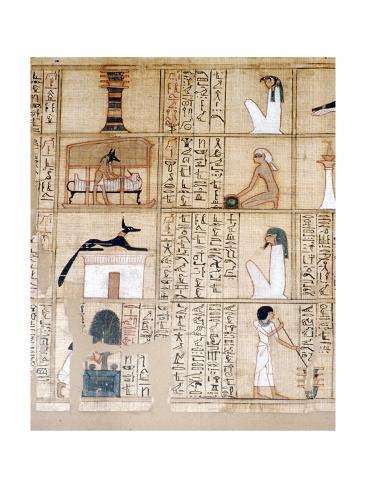
It was believed that Anubis was the one who invented the process of mummification. She was probably related to mummification where she would fortify the body against corruption, so it would stay fresh for reanimation by the deceased’s ka. She was thought to give water to the spirits of the dead while they waited for the mummification process to be complete.

She was the goddess of freshness and purification through water who washed the entrails of the deceased and brought the sacred water to Anubis for his tasks. He was thought to have a daughter known as Kebechet (Kabechet, Kebehut), who was depicted as a snake or ostrich carrying water. In one train of thought, it was believed that Isis raised him, as Set might murder his wife’s illegitimate son, and so he grew up a friend and follower of Osiris. He is sometimes called the son of Nephthys and Set or of Nephthys and Osiris. It was thought that he would be magically become the funerary god himself and so be able to legitimately cut open the corpse for the mummification process. The priest who took on this role was called the ‘Overseer of the Mysteries’ (hery seshta). The preliminary stages of mummification involved the opening – the violation – of the body, an action that only Anubis himself would have been allowed to perform. The funerary stm priests would wear a mask of the jackal god during the mummification process, symbolically becoming the god for the rituals. As this happened, Anubis became ‘He Who is Before the Divine Booth’, the god of embalming who presided over the funerary rituals. When the Osiris worship came to power, Osiris took over many of Anubis’ jobs as caretaker and protector of the dead. The animal is sometimes referred to as the ‘Anubis animal’ as it is unknown which exact species of canine that Anubis actually was based on. Though to the Egyptians there was not a great deal of difference between the two canines, so there is some confusion over which animal Anubis actually was. To the Egyptians, Anubis was the protector of embalming and guardian of both the mummy and the necropolis.Īnubis was often identified by the word sab, ‘jackal’ rather than ‘ dog‘ (iwiw). Anubis was also seen as the deity of embalming, as well as a god of the dead. Black was also the color of fertility, and thus linked to death and rebirth in the afterlife. (It has been noticed by Flinders Petrie that the best guides to Egyptian tombs are the jackal-trails.) Anubis was painted black to further link him with the deceased – a body that has been embalmed became a pitch black color. The Egyptians would have noticed the jackals prowling around the graveyards, and so the link between the animal and the dead was formed in their minds. He was generally depicted as a black jackal-headed man, or as a black jackal. In the text, it was written that “Unas standeth with the Spirits, get thee onwards, Anubis, into Amenti, onwards, onwards to Osiris.” In the pyramid texts of Unas, his role was already very clear – he was associated with the Eye of Horus and he was already thought to be the guide of the dead in the afterlife, showing them the way to Osiris.

(Khenty Amentiu was the name of a previous canine deity who was superseded by Anubis.) The worship of Anubis was an ancient one – it was probably even older than the worship of Osiris. He was known as the ‘Lord of the Hallowed Land’ – the necropolis – and Khenty Amentiu, ‘Foremost of the Westerners’ – the Land of the Dead was thought to be to the west, where the Egyptians buried their dead. Anubis (Inpew, Yinepu, Anpu) was an ancient Egyptian god of the underworld who guided and protected the spirits of the dead.


 0 kommentar(er)
0 kommentar(er)
